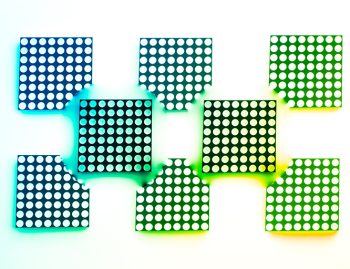
When it comes to specifying the right LED for your device, color and brightness are just the start. The choice of mounting types can have a major impact on manufacturability, durability, cost, and design flexibility.
LEDs are available as through-hole devices or surface-mount devices (SMDs).
- Through-hole LEDs: The chip is protected in an epoxy resin case (see figure 1). The anode and cathode pins project from the case; the number of wires depends on whether the device is a single color or multi-color LED. To mount the LED, the pins are threaded Through-holes drilled in the PCB and soldered on both front side and back side.
- SMD LEDs: The emitter chip is installed in a ceramic mount that is soldered onto the surface of the PCB. SMDs do not require any holes to be drilled through the board.

Figure 1: The dies of through-hole LEDs are protected by epoxy-resin cases. Afrank99, CC BY-SA 2.0 <https://creativecommons.org/licenses/by-sa/2.0>, via Wikimedia Commons
Here, we consider the pros and cons of each type and how to decide on the best approach for a given application.
Will your device be subjected to high levels of shock and vibration?
For applications involving high shock and vibration, such as military/aerospace, autonomous guided vehicles (AGVs), or industrial, through-hole LEDs provide an extra measure of stability.
In addition to the solder bond, they get additional mechanical strength from running the pins through the board.
Will you be using automated assembly?
It’s not enough to design a device that works. It has to allow cost-effective volume manufacturing. Through-hole LEDs require manual assembly. Because SMD LEDs are mounted on one side of the board, they are well suited to robotic pick-and-place assembly.
Automated assembly increases throughput and yield while reducing cost.
Do you have a complex board layout?
Through-hole LEDs require holes to be drilled in the board. This not only adds an extra manufacturing step, it also constrains board layout.
This can be a particular issue for complex or multilayer devices. SMD LEDs are surface mounted, so they don’t require holes to be drilled in the board.
Is your device space constrained?
SMD LEDs are ultra-low profile, especially those with flat lenses.
They are generally smaller than through-hole versions ¾ as an example, the SMD LED shown below is 1.6 mm x 1.5 mm x 0.6 mm. This makes them very good fits for space-constrained applications like portable devices.
Conversely, adapters are available for through-hole LEDs that can raise them multiple millimeters off the surface of the board.

Figure 2: The Bivar SM0605BC-R/B, a red/blue SMD LED that measures just 1.6 mm x 1.5 mm x 0.6 mm [source: Bivar datasheet]
Are you building a prototype?
The bendable pins of through-hole LEDs make them compatible with breadboards. They are also easier to swap out for repairs or upgrades.
As with most things in engineering, there is no ideal mounting type. The choice is very much driven by the constraints of the application and the requirements for an individual product. Consider the requirements of your application and project and prioritize your needs so you can make informed trade-offs.
Most of all, don’t leave the decision until the end. Starting early will provide greatest flexibility in the design process and best results.
For more information on the design trade-offs between through-hole and surface-mount LEDs, contact your Bivar representative.
Leave a Reply Cancel reply
You must be logged in to post a comment.









